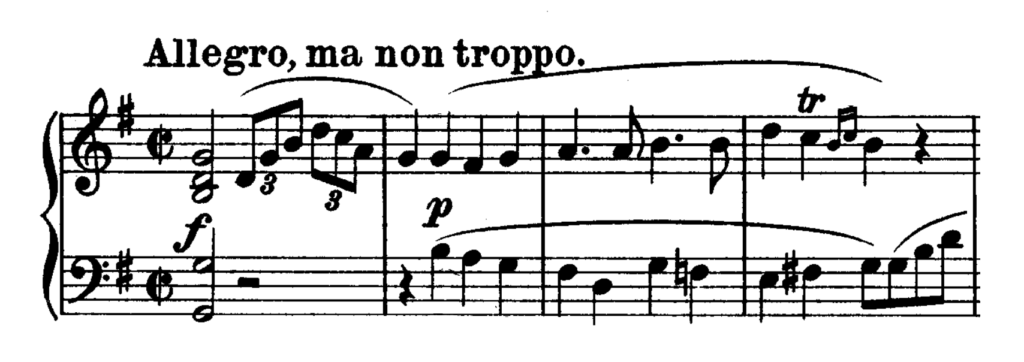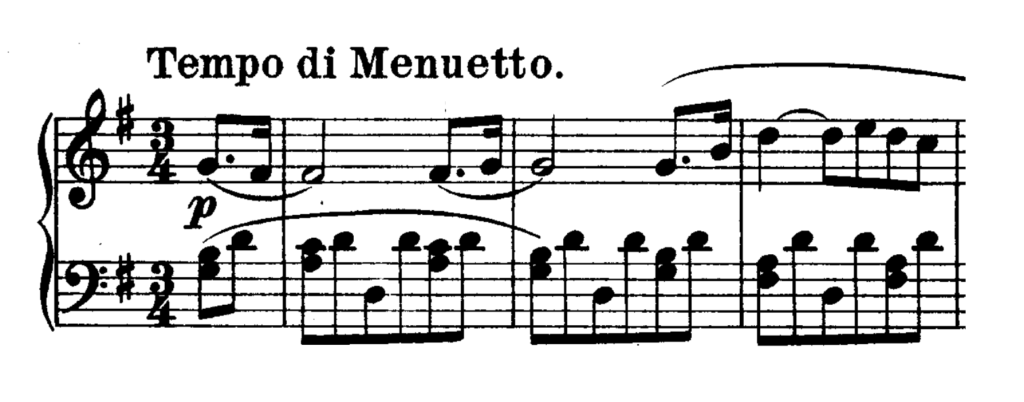Analysis
Contents
For the benefit of all pianists learning this work, we present to you a concise and easy to use analysis of Beethoven’s Piano Sonata No.20 in G major.
First Movement (Allegro Ma Non Troppo)
Form: Sonata Form. G Major.
EXPOSITION:
Bars 1-12: First Subject in G major (tonic). The first subject consists of two sections of four bars each, Bars 1-4 and 8-12 (Bars 5-8 being a repetition of the first section an eighth higher).
Bars 12-20: Connecting Episode. The connecting episode, which commences with a reference to the second section of the fist subject, is in the key of the tonic, except a transient modulation to the dominant at Bar 15, at which bar there is a dominant pedal point, which continues to Bar 20.
Bars 20-49: Second Subject in D major. The second subject is in two parts. The first part, which ends in the key of A major, Bars 20-28, is repeated, Bars 28-36, altered at the end so as to close in D major. The second part begins and ends in the dominant key, Bars 36-49.
Bars 49-52: Coda. The Coda is formed upon the connecting episode figure.
Double bar and repeat.
DEVELOPMENT:
Bars 53-67: The development begins in A minor, modulates to E minor, Bar 57, and ends in G major, Bars 66-67.
RECAPITULATION:
Bars 67-70: First subject in original key. The second section of the first subject (Bars 8-12) is omitted, and there is only a partial recurrence of the repetition of the first section.
Bars 71-87: Connecting Episode. The connecting episode is considerably altered. It commences with the first section of the first subject (Bar 71), but it modulates to C major, Bars 74-75, and is extended into a five-bar phrase. The succeeding part of the episode (Bars 75-81) is derived from the second part of the second subject (Bars 36-49). It ends with the closing part of the original connecting episode.
Bars 87-116: Second Subject in G major (tonic). The second subject and Coda are transposed into the tonic key.
Bars 116-End: Coda. The second subject and Coda are transposed into the tonic key.
Second Movement (Tempo Di Menuetto)
Form: Rondo Form. G Major.
FIRST PART:
Bars 1-21: First Subject in G major (tonic). This theme is also used by Beethoven in his Septet.
Bars 21-43: Episode. New material is used for this episode; it commences with a four-bar phrase in the tonic key, followed by a four-bar phrase in the dominant key ending in A major, Bar 29. The bass of Bars 22-23 is used in the treble, Bars 26-27. At Bar 29 a new figure is introduced, also a pedal point upon the dominant of D. The episode ends in the key of D, Bar 43.
Bars 43-48: Bars 43-48 form a connecting passage modulating to tonic key.
Bars 38-68: First Subject in original key. The first subject re-appears unaltered.
SECOND PART:
Bars 68-88: This episode in C major consists of two sections: first section, Bars 68-72; second section, Bars 72-76; both are repeated, but at the close of the second subject there is a modulation to G, and it is extended, forming a connecting passage to the third entry of the first subject.
THIRD PART:
Bars 88-108: First Subject in original key. The re-appearance of the episode and the fourth entry of the first subject are omitted.
Bars 108-End: Coda. The Coda, which refers to the first subject, begins with transient modulations to the keys of C major and A minor, after which it concludes in tonic key.








